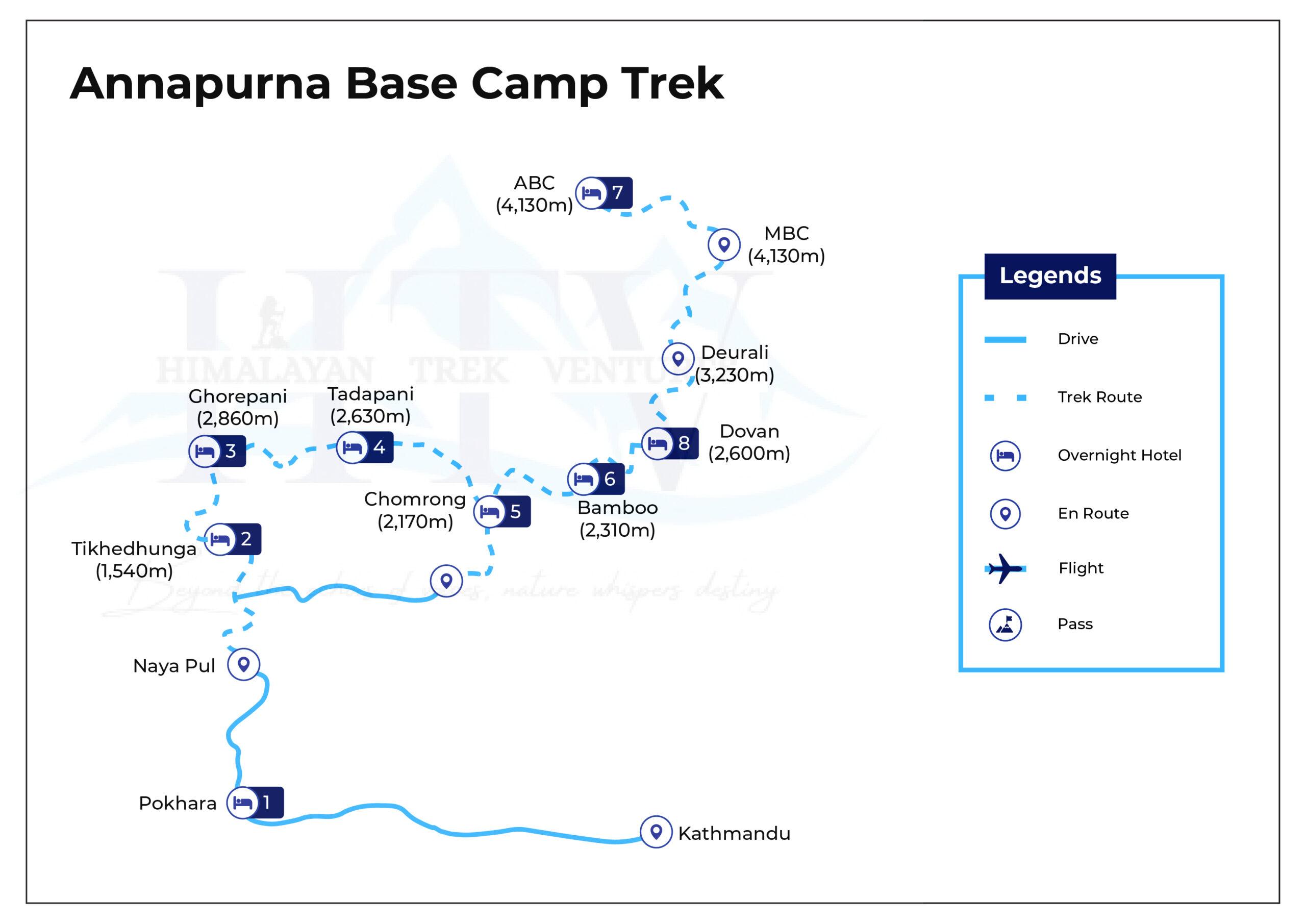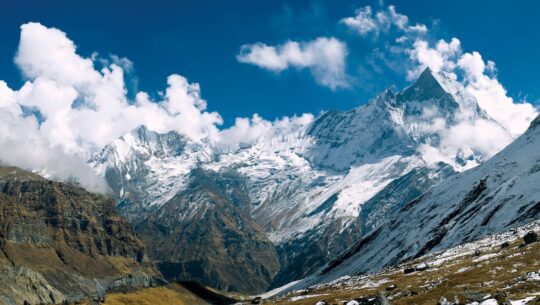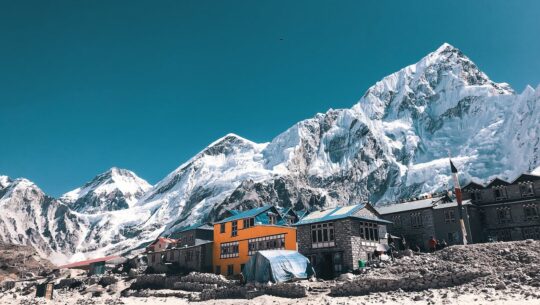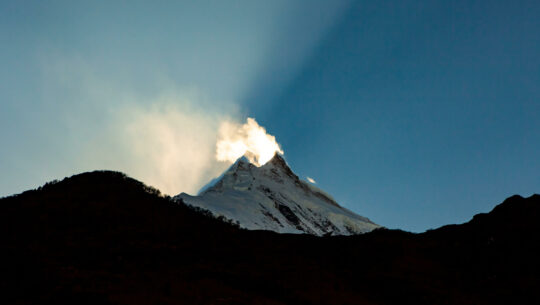Annapurna Base Camp Trek-14 Days
14 Days
Moderate
4,130 meters
Local teahouses and lodges
2 - 12
Autumn (September–November) and Spring (March–May)
Annapurna Base Camp Trek-14 Days Introduction
The 14-day Annapurna Base Camp Trek, with options for the Mardi Himal or Dhampus extension, offers an amazing Himalayan experience. Through the heart of Nepal’s Annapurna region, this trek combines vibrant local culture with stunning mountain scenery. From the tranquil city of Pokhara, you will travel through high alpine meadows, traditional Gurung villages, and lush rhododendron forests before arriving at the magnificent Annapurna Base Camp (4,130m).
The Mardi Himal or Dhampus extension offers sweeping views of Machapuchhre, Annapurna South, and the surrounding peaks as it follows the traditional ABC trail through more sedate paths and ridgelines. The trail’s natural hot springs at Jhinu Danda, picturesque villages, and cosy teahouse lodgings are all intended to offer a well-balanced combination of comfort, challenge, and cultural immersion.
Who is This Trek For?
This 14-day version of the Annapurna Base Camp Trek — with a scenic extension to Mardi Himal or Dhampus — is designed for:
First-Time Trekkers
Ideal for those new to high-altitude trekking who want a longer, paced, and scenic Himalayan experience.
Nature Enthusiasts
Perfect for travelers looking to explore diverse ecosystems — from rhododendron forests to alpine meadows — while spotting birds, langur monkeys, or even musk deer.
Cultural Travelers
Engage with the authentic lifestyle of Gurung and Magar communities in villages like Chhomrong, Tadapani, and Dhampus.
Moderately Fit Adventurers
Suitable for those comfortable walking 5–7 hours a day at varied elevations, with gentle ascents and time to acclimatize properly.
Photographers and Peace Seekers
From panoramic ridge walks to silent dawns at base camp, this trek is also for those seeking inspiration, solitude, or visual beauty.
Highlights
- Magnificent sweeping views of Dhaulagiri, Hiunchuli, Machapuchhre (Fishtail), and Annapurna I
- Discover the village cultures of the Gurung and Magar.
- Poon Hill, one of Nepal’s most famous vantage points, at sunrise
- Various ecosystems, including alpine meadows, bamboo groves, and subtropical forests
- Relax after a trek at Jhinu Danda’s natural hot springs.
- peaceful and picturesque extension of the Dhampus ridgeline or Mardi Himal
- Cosy teahouse accommodations with friendly service
- Professional assistance for safety and local knowledge during a guided walk
Outline Itinerary
- Day 1: Reaching Pokhara (1,400m)
- Day 2: Nayapul (1,070m) to Pokhara Hike to 1,540-meter Tikhedhunga | About four to five hours of trekking
- Day 3: Ghorepani (2,860m) to Tikhedhunga. About 6–7 hours of trekking
- Day 4: Trek to Tadapani (2,630m) and Ghorepani to Poon Hill (3,210m) | About five to six hours of trekking
- Day 5: 2,170-meter journey from Tadapani to Chhomrong. About five to six hours of trekking
- Day 6: 2,310-meter trek from Chhomrong to Bamboo: About five hours of trekking
- Day 7: Deurali (3,230m) to Bamboo. About six hours of trekking
- Day 8: Travel to Annapurna Base Camp (4,130m) via Deurali. About five hours of trekking
- Day 9: Dovan (2,600m) from Annapurna Base Camp. About six hours of trekking
- Day 10: Dovan to 1,780-meter Jhinu Danda, about five hours of trekking
- Day 11: Drive to Pokhara from Jhinu Danda to Nayapul (1,070m) | About three hours of trekking
- Day 12: Dhampus (1,620m) to Pokhara. The 1,200-meter trek to Phedi takes about four hours of trekking
- Day 13: Phedi to Australian Camp (2,060m) — Walk to 2,400-meter Forest Camp | About six hours of trekking
- Day 14: Drive to Pokhara from Forest Camp to Kande (1,750m) | About three hours of trekking
Detailed Itinerary
Day 1: Reaching Pokhara (1,400m)
Reach Pokhara, the picturesque lakeside city in Nepal and the gateway to the Annapurna region. After checking into your hotel, meet your guide for a pre-trek briefing. Take advantage of this day to get your equipment ready, relax, and take in the peaceful surroundings of Phewa Lake while taking in the views of the mountains.
Day 2: Nayapul (1,070m) to Pokhara Hike to 1,540-meter Tikhedhunga | About four to five hours of trekking
Your trek officially starts at Nayapul, which is about a 1.5-hour drive away. The trail winds through forests, tiny villages, and verdant farmland as it follows the placid Modi River. You will arrive at Tikhedhunga, where you will spend your first night trekking, after a pleasant walk on largely level ground. The last approach is a steep stone-step climb.
Day 3: Ghorepani (2,860m) to Tikhedhunga. About 6–7 hours of trekking
Get ready for a difficult day! Start with a challenging and steep climb up hundreds of stone steps through thick oak and rhododendron forests. Before reaching Ghorepani, a sizable Gurung community situated atop a ridge with breathtaking sunset views, the trail winds through a number of tiny villages and rewards your efforts with breathtaking mountain views.
Day 4: Trek to Tadapani (2,630m) and Ghorepani to Poon Hill (3,210m) | About five to six hours of trekking
Get up early for a quick 45-minute walk to Poon Hill, which is well-known for its expansive sunrise views of the Annapurna, Dhaulagiri, Machapuchhre, and other Himalayan giants. Return to Ghorepani for breakfast after taking in the breathtaking views, and then make your way slowly down through terraced farmland and rhododendron forests.
Day 5: 2,170-meter journey from Tadapani to Chhomrong. About five to six hours of trekking
Cross multiple suspension bridges over roaring rivers and descend sharply through dense forests. After that, the trail progressively climbs to Chhomrong, one of the biggest Gurung villages nearby. Amid traditional village life, Chhomrong is the ideal place to unwind and take in breathtaking views of Machapuchhre and Annapurna South.
Day 6: 2,310-meter trek from Chhomrong to Bamboo: About five hours of trekking
The walk takes you through thick bamboo and rhododendron forests after crossing suspension bridges over the Modi Khola river. Before reaching Bamboo, a quiet village surrounded by lush vegetation and towering cliffs, the trail gently climbs and descends through breathtaking scenery.
Day 7: Deurali (3,230m) to Bamboo. About six hours of trekking
As you enter the alpine zone, climb steadily through forests of rhododendron and bamboo, progressively increasing your altitude. The trail winds through rocky areas and steep terrain. With breathtaking views of the mountains, Deurali is a small community that offers rustic lodging. The entrance to the lofty Annapurna Sanctuary is located here.
Day 8: Travel to Annapurna Base Camp (4,130m) via Deurali. About five hours of trekking
The highlight of the day is today! To get to the Annapurna Base Camp, hike through glacial moraine and alpine meadows dotted with wildflowers. Annapurna I, Annapurna South, Machapuchhre, and Hiunchuli are among the majestic peaks that encircle this area. A genuine high Himalayan experience, the ambiance is enchanting, and the views are stunning.
Day 9: Dovan (2,600m) from Annapurna Base Camp. About six hours of trekking
Start down the same path, traversing alpine meadows and moraine fields. You will arrive at Dovan, a peaceful location next to a river with imposing cliffs in the area. After a long day, relax and take in the tranquil surroundings.
Day 10: Dovan to 1,780-meter Jhinu Danda, about five hours of trekking
Proceed downhill through terraced fields and verdant forests. Trekkers can soak their aching muscles in the natural hot springs at Jhinu Danda, which are well-known for this feature. Before the last day of trekking, this is the ideal place to rest.
Day 11: Drive to Pokhara from Jhinu Danda to Nayapul (1,070m) | About three hours of trekking
To get to Nayapul, descend via farm fields and wooded paths. Drive back to Pokhara from here. Enjoy a leisurely evening in this lively lakeside town to commemorate the successful completion of your trek.
Day 12: Dhampus (1,620m) to Pokhara. The 1,200-meter trek to Phedi takes about four hours of trekking
Travel by car or on foot to Dhampus, a traditional village with sweeping views of the Machapuchhre and Annapurna mountain ranges. Before you descend to Phedi, where you will spend the night, spend some time taking in the village’s cultural attractions.
Day 13: Phedi to Australian Camp (2,060m) — Walk to 2,400-meter Forest Camp | About six hours of trekking
Climb past terraced fields and through verdant forests to Australian Camp, a well-liked vantage point known for its expansive mountain views and breathtaking sunrises. Trek further to Forest Camp, which offers a quiet and serene place to stay amidst dense rhododendron forests.
Day 14: Drive to Pokhara from Forest Camp to Kande (1,750m) | About three hours of trekking
To get to Kande, descend via farmland terraces and forest paths. After that, continue your extended Annapurna trekking adventure by driving back to Pokhara.
Includes
- Hotel and airport transfers in Pokhara and Kathmandu.
- Every mode of transportation is according to the schedule
- knowledgeable porters and trekking guides who speak English
- Teahouses and hotels in Pokhara during the trek
- Every meal—breakfast, lunch, and dinner—during the trek
- Permits for trekking (Annapurna Conservation Area Permit and TIMS)
- A visit to Jhinu Danda’s natural hot springs
- Service fees and taxes levied by the government
Excludes
- International travel to and from Nepal
- Visa fees for Nepal
- Insurance for travel and rescue (required)
- Equipment and personal trekking gear
- Advice for porters and guides
- Unless otherwise noted, meals in Kathmandu and Pokhara
- Personal costs (phone calls, laundry, drinks, etc.)
- Any activities that are not on the itinerary
Trip Map

Gear List
- Trekking boots that are comfortable and well-worn
- Warm insulated jacket (synthetic or down)
- Mid-layer of fleece or soft shell
- Thermal base layers
- Waterproof trousers and jacket







